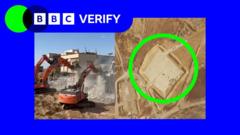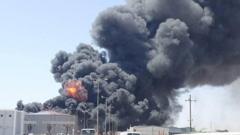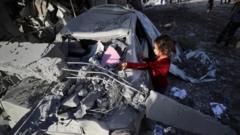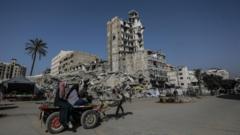Recent developments indicate that Israel is setting up distribution hubs in Gaza to facilitate humanitarian aid deliveries. The initiative has been met with opposition from the UN and various humanitarian groups, who argue that it undermines essential humanitarian principles and exacerbates the ongoing crisis.
New Humanitarian Distribution Hubs Emerge in Gaza Amid Ongoing Controversy

New Humanitarian Distribution Hubs Emerge in Gaza Amid Ongoing Controversy
Satellite imagery reveals the establishment of potential humanitarian distribution sites in Gaza as part of an Israeli-US aid initiative, facing criticism from the UN and humanitarian organizations.
Recent satellite images have showcased Israel’s initiatives to build humanitarian distribution hubs in Gaza, coinciding with a controversial plan supported by the US. The construction of these sites comes after Israel suspended the delivery of food and medicine to the enclave in March, a decision condemned by numerous international leaders, including those from the UN and Europe. Israeli officials claim this blockade is aimed at pressuring Hamas to release hostages, while Hamas has denied accusations of misappropriating aid.
The UN has warned that the prolonged blockade has plunged Gaza, home to approximately 2.1 million residents, into severe crises of food, medicine, and fuel shortages, as assessments highlight a "critical risk" of famine. Amidst this backdrop, the US recently announced a framework for aid distribution that relies on private companies, security contractors, and Israeli forces to support the establishment of hubs throughout Gaza.
Reports indicate that land has been cleared for new roads and staging areas that may support these distribution sites. While the Israeli government has not disclosed their exact locations, humanitarian sources have indicated at least four centers will be located in southern Gaza, with an additional center planned for the north near the Netzarim Corridor. The Gaza Humanitarian Foundation initially proposed the initiative with intentions to aid around 1.2 million people, yet has faced backlash for not adequately addressing the needs of the entire population.
UN agencies have categorically refused to cooperate with the initiative, asserting it violates core humanitarian principles and effectively militarizes aid distribution. A spokesperson for the UN’s Office for the Co-ordination of Humanitarian Affairs accused Israel of using humanitarian aid as leverage in its military strategy, while other humanitarian organizations, like Oxfam, denounced the plan as ineffective against the broader humanitarian crisis.
Recent satellite analyses reveal considerable activity at the identified sites, indicating they will likely secure distribution centers. Observations show construction efforts surrounding one site near an IDF base, which is stocked with defensive barriers. Military analysts corroborate that the layout of these facilities suggests strict control by Israeli forces.
The situation is increasingly complex as the IDF has reinforced its military presence in southern Gaza, including newly constructed roads and military zones like the Morag Corridor, which further isolates the population. Humanitarian experts maintain that the restrictions imposed by Israel violate international obligations to ensure basic needs are met for the enclave’s residents. While Israel claims compliance with international law and expresses that aid is adequate within Gaza, humanitarian groups continue to argue for unrestricted access and a lifting of the blockade to address the escalating crisis.





















